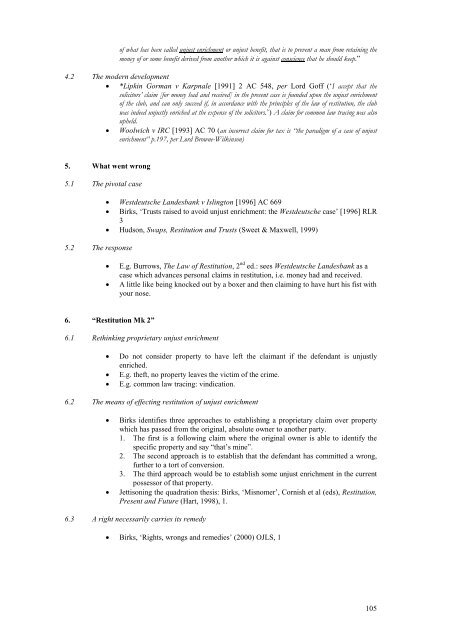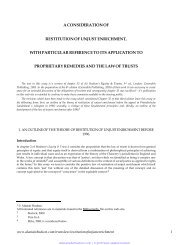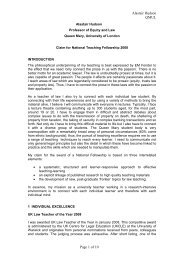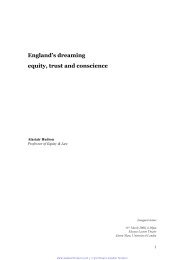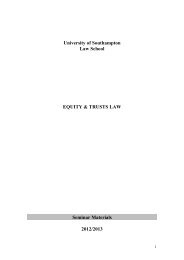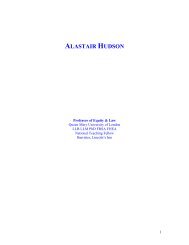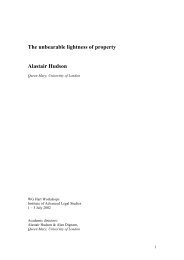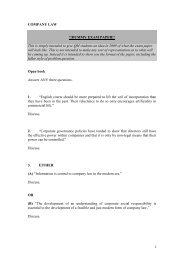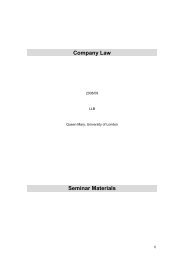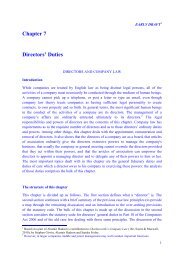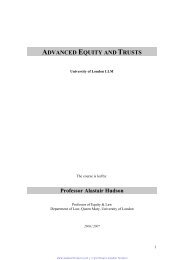Soton Equity and Trusts - alastairhudson.com
Soton Equity and Trusts - alastairhudson.com
Soton Equity and Trusts - alastairhudson.com
Create successful ePaper yourself
Turn your PDF publications into a flip-book with our unique Google optimized e-Paper software.
of what has been called unjust enrichment or unjust benefit, that is to prevent a man from retaining the<br />
money of or some benefit derived from another which it is against conscience that he should keep.”<br />
4.2 The modern development<br />
*Lipkin Gorman v Karpnale [1991] 2 AC 548, per Lord Goff (‘I accept that the<br />
solicitors’ claim [for money had <strong>and</strong> received] in the present case is founded upon the unjust enrichment<br />
of the club, <strong>and</strong> can only succeed if, in accordance with the principles of the law of restitution, the club<br />
was indeed unjustly enriched at the expense of the solicitors.’) A claim for <strong>com</strong>mon law tracing was also<br />
upheld.<br />
Woolwich v IRC [1993] AC 70 (an incorrect claim for tax is “the paradigm of a case of unjust<br />
enrichment” p.197, per Lord Browne-Wilkinson)<br />
5. What went wrong<br />
5.1 The pivotal case<br />
5.2 The response<br />
Westdeutsche L<strong>and</strong>esbank v Islington [1996] AC 669<br />
Birks, ‘<strong>Trusts</strong> raised to avoid unjust enrichment: the Westdeutsche case’ [1996] RLR<br />
3<br />
Hudson, Swaps, Restitution <strong>and</strong> <strong>Trusts</strong> (Sweet & Maxwell, 1999)<br />
<br />
<br />
E.g. Burrows, The Law of Restitution, 2 nd ed.: sees Westdeutsche L<strong>and</strong>esbank as a<br />
case which advances personal claims in restitution, i.e. money had <strong>and</strong> received.<br />
A little like being knocked out by a boxer <strong>and</strong> then claiming to have hurt his fist with<br />
your nose.<br />
6. “Restitution Mk 2”<br />
6.1 Rethinking proprietary unjust enrichment<br />
<br />
<br />
<br />
Do not consider property to have left the claimant if the defendant is unjustly<br />
enriched.<br />
E.g. theft, no property leaves the victim of the crime.<br />
E.g. <strong>com</strong>mon law tracing: vindication.<br />
6.2 The means of effecting restitution of unjust enrichment<br />
<br />
<br />
Birks identifies three approaches to establishing a proprietary claim over property<br />
which has passed from the original, absolute owner to another party.<br />
1. The first is a following claim where the original owner is able to identify the<br />
specific property <strong>and</strong> say “that’s mine”.<br />
2. The second approach is to establish that the defendant has <strong>com</strong>mitted a wrong,<br />
further to a tort of conversion.<br />
3. The third approach would be to establish some unjust enrichment in the current<br />
possessor of that property.<br />
Jettisoning the quadration thesis: Birks, ‘Misnomer’, Cornish et al (eds), Restitution,<br />
Present <strong>and</strong> Future (Hart, 1998), 1.<br />
6.3 A right necessarily carries its remedy<br />
Birks, ‘Rights, wrongs <strong>and</strong> remedies’ (2000) OJLS, 1<br />
105


